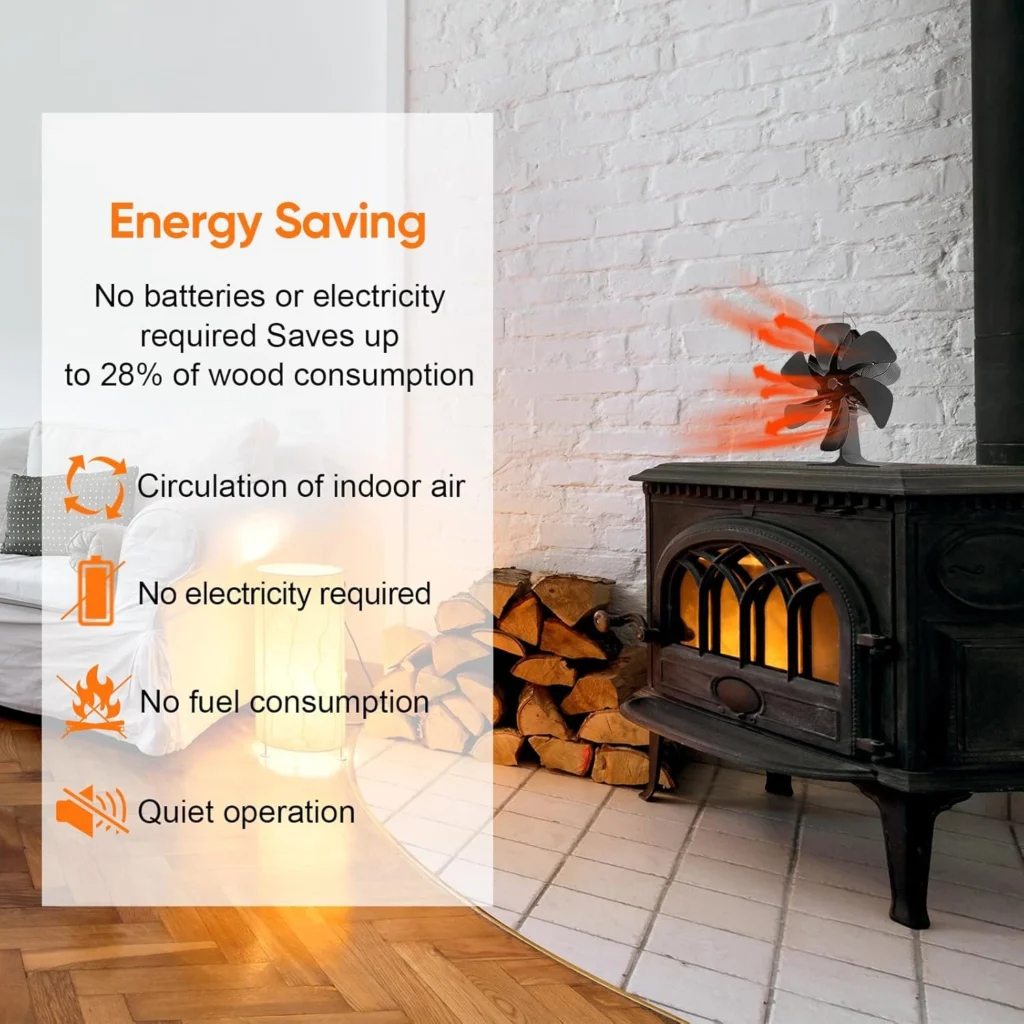When it comes to heating your home, nothing beats the charm of a traditional wood stove. It creates a cozy, inviting atmosphere while helping you reduce your reliance on electricity and fossil fuels. However, one challenge with wood stoves is that the heat tends to accumulate near the stove, leaving other areas of the room colder. This is where a wood stove fan comes into play. A wood stove fan can significantly improve your stove’s performance, ensuring that heat is distributed evenly across the room, making your home more comfortable and energy-efficient.
In this comprehensive guide, we will explore everything you need to know about wood stove fans: how they work, their benefits, how to choose the right one, and much more.


Wood Stove Fan, Fireplace Fan with Wood Stove Magnetic Thermometer, 6-Blade Heat Powered Stove Fan for Wood/Log Burners/Fireplaces/Heaters
| Price: | $35.99$35.99 |
| $28.79 with Prime membership | |
| Brand | AhmyLion |
| Color | Black |
| Electric fan design | Table Fan |
| Power Source | Heat Powered |
| Style | Modern |
| Product Dimensions | 4.45″D x 4.43″W x 7.64″H |
| Special Feature | Heat Powered, Quiet Operation, Buddy Heater Combo Accessories |
| Recommended Uses For Product | Exhausting |
| Noise Level | 25 dB |
| Finish Type | Aluminum baking paint |
What is a Wood Stove Fan?
A wood stove fan is a device designed to circulate warm air more efficiently from your stove, ensuring that the heat produced by your fire is evenly distributed throughout the room. These fans are typically heat-powered, which means they don’t require any electricity to operate. Instead, they are powered by the heat emitted by the stove itself.
The fan works by using a thermoelectric module, which generates electricity when exposed to heat. This electricity powers the fan blades, which circulate warm air away from the stove and into the room. This distribution of heat ensures that areas of the room farther from the stove remain warm, improving comfort and increasing the overall efficiency of your heating system.
How Do Wood Stove Fans Work?
The mechanics of a wood stove fan are relatively simple but incredibly effective. When you start a fire in your wood stove, it generates heat. This heat warms the bottom of the wood stove fan, which houses a thermoelectric module. This module creates a temperature difference between its two sides—the hot side and the cool side.
The temperature difference generates a small amount of electricity, which powers a small motor that drives the fan blades. As the fan blades spin, they push warm air away from the stove and circulate it throughout the room. This process helps prevent the heat from rising and gathering near the ceiling and ensures it is distributed evenly throughout the space.
The more heat produced by the stove, the faster the fan blades will spin, increasing the airflow and circulation of warm air. Once the stove cools down, the fan will automatically slow down or stop, conserving energy and ensuring that your wood stove fan works only when it’s needed most.
Key Benefits of Using a Wood Stove Fan
Using a wood stove fan offers numerous advantages, making it a worthwhile investment for anyone who uses a wood stove to heat their home. Here are some of the key benefits:
- Improved Heat Distribution
The most significant benefit of using a wood stove fan is that it helps distribute heat more evenly throughout the room. Without a fan, the heat from your stove tends to rise directly above the stove, leaving colder areas in the room. A wood stove fan helps to circulate that warm air more effectively, so you don’t have to deal with hot and cold spots in your room. This leads to a more comfortable living space.
- Increased Heating Efficiency
By improving the circulation of heat, a wood stove fan allows you to get more heat from the same amount of wood. This means that your stove will work more efficiently, and you’ll need to burn less wood to heat your space. Over time, this can lead to significant savings on heating costs, especially in colder climates where wood stoves are used regularly.
- Eco-Friendly
Since wood stove fans don’t require any electricity, they are an eco-friendly option for improving your heating system. They operate solely using the heat from your stove, which means no additional energy consumption. This makes them an ideal choice for anyone looking to reduce their environmental footprint while still enjoying the benefits of efficient heating.
- Silent Operation
Another notable advantage of a wood stove fan is its quiet operation. These fans are designed to be as silent as possible, which means you can enjoy the warmth of your stove without any distracting noise. Unlike traditional electric fans, which can be noisy, a wood stove fan operates quietly and unobtrusively, adding to the cozy ambiance of your home.
- No Need for Electricity
One of the key selling points of wood stove fans is that they don’t require an external power source. This makes them particularly useful in off-grid homes, cabins, or during power outages. You can continue to enjoy efficient heat distribution even if the power goes out, which is a huge benefit during winter months.
- Cost-Effective
Given that wood stove fans are relatively inexpensive and don’t require electricity, they provide a cost-effective way to improve your stove’s performance. The initial investment is often recouped through savings on fuel, as your stove will burn less wood to heat the same space.
Types of Wood Stove Fans
There are several different types of wood stove fans available on the market, each with its own set of features and benefits. Here’s a breakdown of the most common types:
- Heat-Powered Wood Stove Fans
These are the most popular type of wood stove fan. They are powered entirely by the heat from your stove, requiring no electricity to operate. They feature thermoelectric modules that convert heat into electricity, which powers the fan blades. Heat-powered fans are available in a variety of sizes and designs, and they are typically placed on top of the stove for optimal heat exposure.
- Electric Wood Stove Fans
While less common, electric wood stove fans do exist. These fans are powered by electricity rather than heat, which means they can offer more control over fan speed and airflow. However, they do consume electricity, which makes them less eco-friendly and may reduce some of the savings you get from using a wood stove fan. These fans are ideal for people who want more powerful fans for larger spaces.
- Variable-Speed Fans
Some wood stove fans offer adjustable fan speeds, allowing you to control the amount of airflow. These variable-speed fans are excellent for larger spaces or rooms with different heating requirements. They offer more flexibility, allowing you to increase or decrease the airflow depending on the room’s size and temperature.
- Dual-Blade Fans
For larger rooms or more substantial stoves, a dual-blade wood stove fan can be a great option. These fans have two blades that work in tandem to move more air and distribute heat more efficiently. They are perfect for bigger spaces where a single fan might not provide enough airflow.
How to Choose the Right Wood Stove Fan
When selecting a wood stove fan, there are several factors you need to consider to ensure you get the most efficient and effective fan for your needs. Here are the key considerations:
- Room Size
The size of the room where you plan to use your wood stove fan is one of the most important factors to consider. If you have a large room, you’ll need a fan with more airflow to ensure the heat is distributed effectively. For smaller rooms, a smaller fan may suffice.
- Stove Size and Design
The size and design of your wood stove will also play a role in determining which wood stove fan is best for you. Some fans are designed to work specifically with certain stove models, so it’s essential to check compatibility. Additionally, if your stove is larger, you may need a larger fan to match.
- Fan Speed and Airflow
Look for a wood stove fan that allows you to control the fan speed, especially if you need more precise control over the airflow. Fans with adjustable speeds can be useful for rooms with varying heating needs.
- Noise Level
Most wood stove fans operate quietly, but some may produce more noise than others. If noise is a concern for you, consider choosing a model known for its silent operation. Reading reviews can help you gauge the noise level before making a purchase.
- Build Quality and Durability
Since wood stove fans are exposed to high temperatures, you need a model made from durable, heat-resistant materials. Look for fans constructed from high-quality metals like aluminum, which can withstand heat and last longer.
- Price and Warranty
While wood stove fans are generally affordable, prices can vary based on features, brand, and design. Consider your budget and check for warranty options. A longer warranty can give you peace of mind, knowing that your investment is protected.
Conclusion
A wood stove fan is an invaluable tool for improving the performance and efficiency of your wood stove. By enhancing heat distribution, increasing stove efficiency, and reducing fuel consumption, a wood stove fan helps create a more comfortable and eco-friendly living environment. Whether you have a small cabin or a large home, there’s a wood stove fan that can meet your needs.
When choosing a wood stove fan, consider factors such as room size, stove design, and fan features. By selecting the right fan, you can maximize the heat output from your stove and ensure that your home stays warm throughout the winter months, all while reducing your energy usage and carbon footprint.






